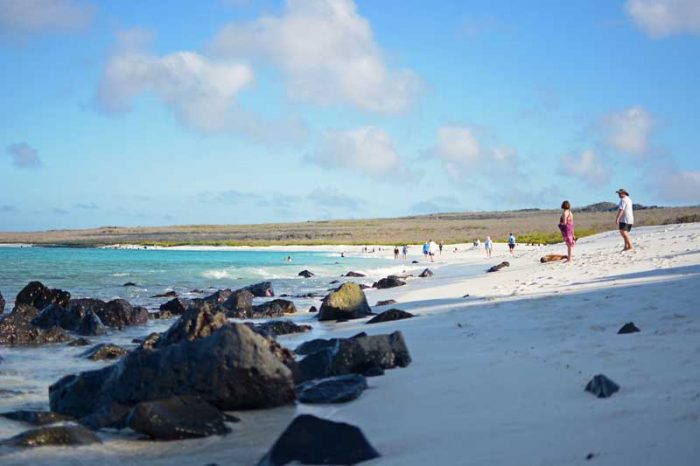If you are a fan of adventure films, you’ve probably dreamt of heroes braving odds far greater than the ordinary, venturing on unexplored territories, seeking lost treasures and solving unknown mysteries.
It is a fact: we are all searching for an experience that surpasses everything we’ve ever dreamt of finding, longing for moments that remain, above all, in memory.
Galapagos formation
Galapagos is a treasure map, each island emerged at its own pace, on a specific place and time, each one holding a different emblematic charm, new territory with different species that colonized it throughout the centuries.
They are no different from other countries: separated by land but unified in spirit. It holds enigmas still unsolved, not even by great scientists such as Charles Darwin (visitor of the islands in 1835), author of his memorable work: On the Origin of Species. Galapagos consists of 20 islands and 42 islets, distributed along the Pacific Ocean, located around six hundred miles away from the mainland of Ecuador.
Formed through a series of underground volcanic eruptions, a hotspot, they surfaced out of the blue from the depths of the earth, designed with a purpose they seemed to be aware of long ago. It’s as if they knew what they were created to do, the oasis that they would eventually become.
Each island was formed at its own time and place, and they all have a specific function and role to play. Contrary to most pieces of land that are birthed from the clash of two tectonic plates, Galapagos is the result of bursts of magma originating from the earth’s core.
The oldest islands, which are Española and South Plaza, are estimated to have around 4 million years old. They are followed by their younger “siblings”: Santa Fe, San Cristobal, North Seymour, Wolf, Santa Cruz, Rabida, Pinzon, Floreana, Baltra, Santiago, Marchena, Isabela, Genovesa, Darwin and its youngest member: Fernandina island. Each was inhabited progressively through time, welcoming its colonizing species with open arms.
They kept on developing and evolving to sustain such a huge and diverse population, a burden few territories have the courage to bear. It has been entrusted with the task to serve as a spring of vitality, the “Aqua de Vida” of ancient legends and tales.
The enchanted islands
How is it possible to many diverse species arrived and gathered at Galapagos? It is currently unknown. For the estimated number of two hundred thousand people that visit the islands every year, they all would probably agree that the experience is close to a Pacific safari, except you are the one that becomes the explorer.
Like the artwork of the greatest artists, the Galapagos are painted with an assortment of colors, shapes, patterns, and sounds, forming a union of a natural masterpiece. Different species of animals that go from iguanas to penguins and a variety of endemic flora and fauna distributed across the islands.
Only to name a few: the Galapagos turtle, emblem of the islands. It habits multiple territories and is known as the proud king of its own “jungle”. The marine iguana, master of both land and seas, the modern-day replica of its prehistoric ancestors, clawing its way as a proud endemic selection of its species. And how can we forget, the missing piece of the puzzle, the penguin, a foreigner who is supposed to belong to the southern end of the earth but has made this territory at the equator its home.
The Galapagos discovery
Before Darwin, others came, most of them resulting from a fortunate accident. There is no confirmed evidence of who were the first people to walk their shores. Spanish historians Pedro Sarmiento de Gamboa and father Miguel Cabello de Balboa, both who lived on the second half of the XVI century, wrote chronicles about stories told by the Incan educators known as “amautas”.
They tell tales of the Incan emperor Túpac Yupanqui, who sailed the sea and discovered the “Ninachumbi” island, translated as Fire Island. There is no certain evidence that this description fits Galapagos, although there is proof that aboriginal life existed in numerous territories.
In 1535, Fray Tomás de Berlanga’s ship was forced to set a different course west of its destination for Peru. In his letters addressed to the Spanish crown, he describes the superabundance and diversity of species dwelling there. Despite indirectly advising that the territory was inhabitable, he rightfully named them the Enchanted Islands.
Pirates, whalers, and buccaneers roamed their shores, using it as a hideout from Spanish ships and ports they raided and as a storage for their belongings. These include Buccaneer Cove on Santiago Island and Tagus Cove, located on Isabela Island. But they also served as a source of inspiration. With mystery and passion, adventure writer Herman Melville tells about his experiences on this voyage. In ten stories compiled as “The Enchanted Isles”, published in 1854, he explores and pours out his heart into these tales that are meticulously described and can be seen fit for a Hollywood film.
Just like its creator, it emerged progressively as years went by until it became known worldwide. It was declared a UNESCO World Natural Heritage in 1978 and Biosphere Reserve six years later and is now one of the biggest touristic attractions in the world.
The story of Galapagos cannot be compressed in a single article. Like a treasure map, it always leaves room for imagination and intrigue. There is something new to discover right around the corner, far beyond. It will be something that we will explore in major depth with each post. The treasures the islands hold go beyond what one can see at plain sight. It is a unique discovery, a singular journey that each one of us takes and experiences. It goes far beyond words, a personal tale we write and we guard in memory.
We invite you to be a part of this singular journey. To find this once-in-a-lifetime opportunity, click on the link below to let your adventure begin!


Leave a Reply